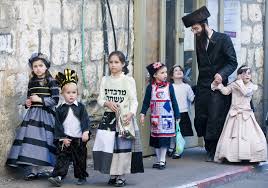
by Talia Beyidna
The Chayei Adam[1]
teaches, “If one has had a miracle performed to save him, and even more so, if
a city has had a miracle that saved it, they have the right to institutionalize
a Purim for that city and to authorize a festive meal that would become a
mitzva, in order to memorialize the wonders of Hashem.”[2]
In fact, the author himself decreed on his family a day of prayer and
celebration after the Vilna fort’s gunpowder magazine exploded in 1803.[3]
A significant part of the neighborhood (and his house) was leveled, and yet,
with Hashem’s kindness, his entire family pulled through and survived. This has
become known as the Gunpowder Purim.
The
Jews of Egypt commemorated an event in 1524, when the governor of Egypt
threatened to massacre them because they refused to join him in a revolt
against the Sultan of Turkey, who at that time ruled Egypt. On the day he vowed
to murder all the Jews in Cairo right after he had finished taking his bath, he
was stabbed to death in the bathhouse by one of his junior officers, and the
massacre was averted. A megilla was
written to tell the story and is read in Egyptian synagogues on what is known
as Purim Cairo on the 28th
of Adar.
Also during the
Ottoman period, the Jewish community of Chevron was saved when a bag of money
mysteriously appeared in a window and enabled them to pay off an extortion fee
to the Ottoman pasha. The community celebrated that salvation with Purim Taka, or Window Purim. In
another incident, Chevron Jews were saved during a battle, leading to the Purim of Ibrahim Pasha.
Throughout our
history, there have been many times when Hashem has performed miracles to save
His people,[4]
and many cities throughout the world have established their own Purims with
their own unique megilla readings.
These holidays have been passed through the generations, interwoven into the
traditions and legacies of the rich cultures of our people. They are
transformed into days of praise and thanksgiving to Hashem, with the highlight
being the reading of the megilla that
was written specifically for their city and miracle.
* * *
Here are some more
instances of communities that maintain in their tradition a celebration of a
second Purim.[5]
One of the best
known second Purims is Purim Vinz,
traditionally celebrated in Frankfurt one week after the regular Purim. Purim
Vinz commemorates the Frankfurt’s Jews’ salvation during the Fettmilch
uprising, in which Vincenz Fettmilch attempted to exterminate the Jewish
community in 1614.
Other second
Purims in commemoration of salvation include Purim Ancona (Ancona, Italy, 21 Teves, 1700s); Purim of the Bandits (Gumeldjina,
Ottoman Empire, 22 Elul, 1786); Purim
Burghul (Tripoli, Libya, 29 Teves, 1795); Purim Narbonne (Narbonne, France, 21 Adar); Purim Rhodes (14 Adar); Purim Sebastiano (Morocco, 1 Elul,
1578); Purim Tiveria (7 Elul
and 4 Kislev, 1743); among many, many more.[6]
Perhaps the most
famous of these Purims is the Pourimopoulo
of the Romaniote Jews of Greece.[7]
Every year, on the 17th of Shevat, they celebrate by gathering
together and reading the megilla
written for this miracle, known as the Megilla
for the Purim Katan of Siracusa.[8]
In the 1300s, their king requested of the Jewish community that, whenever he
paraded through their neighborhood, they should take out the Torah scrolls to
hold them and to kneel before him. However, the Jews removed the Torah scrolls
and honored him with empty cases since, as faithful people, they would only bow
before Hashem.
In the year 1352,
a meshumad Jew by the name of Marcus went to the king and accused the
Jews of dishonoring him by removing the Torahs and greeting him with empty
cases. The king, in a fury, ordered a surprise inspection the following day and
the slaughter of all of the Jews if Marcus’ tip proved correct. That night,
Eliyahu Hanavi appeared in a dream to the caretakers of all 12 synagogues and
told them to return the Torahs to the cases without telling anyone. The next
day, when the king paraded by the Jewish community, he commanded his guards to
open the cases. When he saw that each Torah case contained its Torah scroll,
his anger fell upon Marcus, and he was hanged.
In memory of this
miracle, the descendants celebrate this Purim in the synagogues founded by
their ancestors at Constantinople, Magnesia, Melasso, Smyrna, Aldin, Jerusalem,
and Salonika. This “Little Purim” is memorialized with a host of songs, the
following among them:
Long may you live,
my king! Listen to my words
The Jews are
mocking you, and fake are their respects
They honor you
with empty sefarim and only ask their lives
His servant
Efraim, who worked for his honor,
And His right-hand
man, Eliyahu, sent as His messenger
Wake up, Efraim,
don’t sleep. Decorate the synagogue and get busy,
Decorate the sefarim, fill the letters; decorate them with stars, and tell no
one.
They hanged Marko,
like a stray dog.
Praise to G-d the
Almighty, for he favored the Jews
By sending Eliyaha
?anavi for this great day.
* * *
A miracle
deserving of commemoration happened in our own time. In an attempt to commit
genocide upon the three million Jews living in the USSR, Joseph Stalin devised an
anti-Semitic campaign that included the Doctor’s Plot, as well as a planned
pogrom and deportation of every Jewish man, women, and child to Siberia with no
food or warmth. A few short weeks before his plot was finalized, on Purim,
March 1, 1953, right after Stalin reaffirmed his genocide plan for the Jewish people,
he was struck with a major stroke, averting our destruction.
“I will sing to
Hashem as long as I live, all my life I will melodize to my G-d. May my talk be
sweet to Him, I will rejoice with Hashem.”
[1] Ch 195,
halacha 31. The author of the Chayei Adam, Rabbi Avraham Danzig (1748 Gda?sk –
1820 Vilnius), is considered one of the most preeminent halachic codifiers of
the modern era. Please likewise see the Mishna Brurah ch 218, halacha 32: “One
who has a miracle happen for him, should disseminate charity according to his
abilities… and read the Psalm of thanksgiving. It is likewise proper and
fitting to help with the needs of the community, and every year on this day he
should meditate to praise Hashem, to rejoice, and to tell over Hashem’s
kindness.”
[5] Sources: https://en.wikipedia.org/wiki/Romaniote_Jews,
https://en.wikipedia.org/wiki/Second_Purim, https://esefarad.com/?p=17729,
https://www.jewishmuseum.gr/en/religious-life-jewish-holidays,
https://jewishindependent.ca/oldsite/archives/mar06/archives06Mar10-04.html,
https://en.wikipedia.org/wiki/Doctors%27_plot,
https://www.aish.com/h/purim/t/ts/Stalin-and-the-Purim-Miracle.html
[7] Sources include
Eftihia Nachmias Nachman, Yanina, A Journey to the Past, 39-40; the
director of the Kehila Kedosha Janina museum, as well as the sources in
footnote 7.






